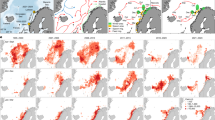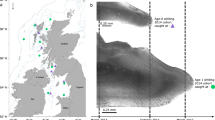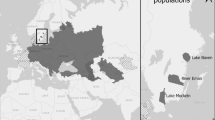Abstract
IDENTIFICATION of groups of herring in the southern North Sea by the size of the central zones on their scales, expressed as a proportion of the total length of the fish, l 1, was first applied by Hodgson1. We have now used it to confirm that in 1952 the recruits to the East Anglian fishery comprised virtually the whole class of three-year-olds, instead of some of them being delayed to their next year of life. The East Anglian fishery is for mature fish, and this change is unusual; it has been sustained ever since 1952. Our Scottish colleagues have repeatedly told us of younger fish also becoming more important in northern groups of herring2. Evidence that had previously caused us to suspect this advancement of maturity is as follows.
This is a preview of subscription content, access via your institution
Access options
Subscribe to this journal
Receive 51 print issues and online access
$199.00 per year
only $3.90 per issue
Buy this article
- Purchase on SpringerLink
- Instant access to full article PDF
Prices may be subject to local taxes which are calculated during checkout
Similar content being viewed by others
References
Hodgson, W. C., Fishery Invest., 2, xi, 7 (1929).
Scottish Home Department Annual Report for 1955. Appendix I (1956).
Author information
Authors and Affiliations
Rights and permissions
About this article
Cite this article
CUSHING, D., BURD, A. Recruitment and Maturity of the East Anglian Herring. Nature 178, 86–87 (1956). https://doi.org/10.1038/178086a0
Issue date:
DOI: https://doi.org/10.1038/178086a0



